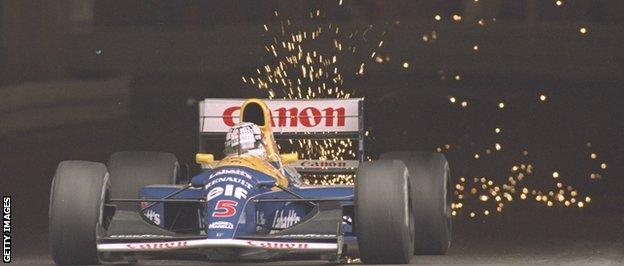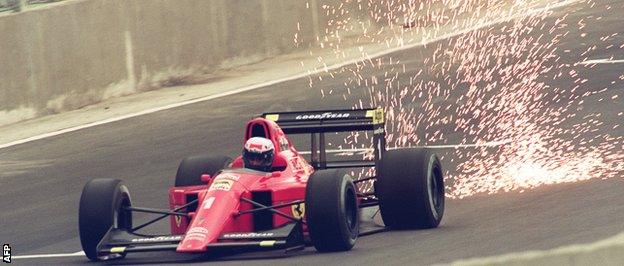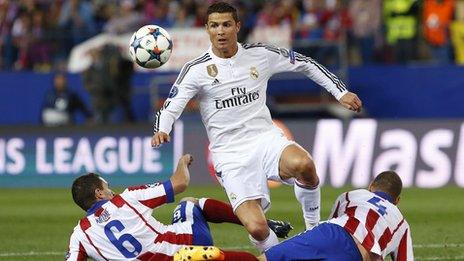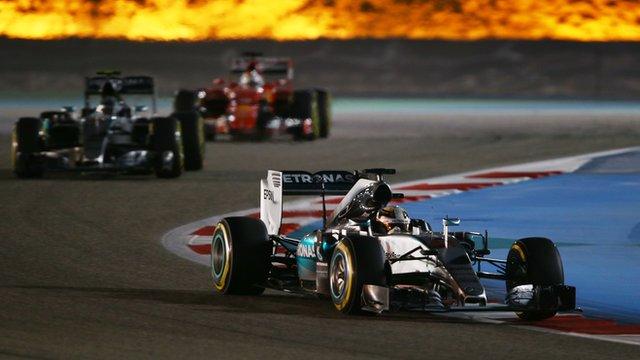Bahrain Grand Prix: Why sparks can make F1 great again
- Published
The Bahrain Grand Prix has become a much more entertaining event since switching to a night race last year and on Sunday it highlighted something the sport has been missing for more than 20 years.
The sparks flying off the back of the cars were a permanent part of Formula 1 in the late 1980s and early 1990s, the halcyon days of Alain Prost, Gerhard Berger, Nigel Mansell and Ayrton Senna.
British McLaren driver Jenson Button did not even make the start of the grand prix due to technical problems, but that enabled him to be as impressed as the rest of us, tweeting, external "Loving the sparks from the cars."
A rule change has brought about the sparks, primarily as a safety precaution but secondly to make the races more pleasing to the eye.

Sparks were caused by a titanium skid block on the underside of the car
More spectacular races
A titanium skid block on the underside of the cars is what turned the back of them into Catherine wheels.
F1's governing body the FIA ruled that cars must be fitted with the skid blocks since the beginning of the season but it has only become a talking point as the sparks were highlighted by the dark of Bahrain's night race.
FIA technical director Charlie Whiting says making the blocks out of titanium makes the cars safer, stops teams from gaining an advantage and creates more sparks, "which some people think will look a little more spectacular".
'Sparks were a weapon and would burn your visor'

Nigel Mansell won the world title in 1992
Titanium plates were fitted on the cars in the 1980s and early 1990s before they were replaced by wood, which meant an end to the sparks
Britain's Nigel Mansell, the 1992 world champion, said:, external "I loved the skid plates, and the sparks. It was such a distraction to anyone following you.
"In free practice I would search out bumps that were slightly offline that I could use in the race if someone was right behind me.
"The lines wouldn't slow me, but I knew would give a big shower of sparks to the guy behind, and hopefully pock-mark their visor too. They really did make burns on your visor."

Like a Scalextric set
It wasn't just Button enjoying the new spectacle. The Williams team tweeted:, external "Sparks in the sky and on the race track. We like!"
Mercedes certainly seemed to think the sparks added to the drama of the race, tweeting:, external "Yes @nico_rosberg! Yes yes yes!!! He's nailed #Vettel into T1 again! Sparks flying everywhere."
Those watching at home also seemed to enjoy the new F1 lightshow.
Matt Burfield tweeted:, external "Whoever came up with the titanium skid plates needs a medal. Fantastic sparks during a night race."
James Heath added: "I've always thought the cars looked great at night, but this year with the added sparks it is fantastic."
While Pedro Silva posted: "With all the sparks flying. Bahrain F1 GP looks like the world biggest Scalextric set."
However, it wasn't a hit with everyone with some purists thinking it was a bad move from the FIA.
Kit Marsden posted: "If the cars are racing hard, and there HAPPEN to be sparks, that's GREAT. But we shouldn't be artificially CREATING sparks."

Alain Prost's Ferrari sparked into life in 1990
There's more to the new sparks than the show, explains chief F1 writer Andrew Benson |
|---|
Formula 1 cars are producing sparks this year because of a conscious effort by teams to improve the show. The idea was proposed by Mercedes last year as a simple fix as part of wider concerns about television audience figures, which were falling in some markets. Replace the heavy-metal skid-blocks under the cars - last year made of tungsten and similar materials - with titanium and you get sparks, immediately rendering the cars more spectacular. Bahrain was proof of the success of the idea. There was a bit more to it than that, however. Rivals suspected that Red Bull had a clever way of running their car lower to the ground than others, for aerodynamic advantage. The theory was that the front part of the floor flexed upwards under load, and the heavy-metal skid blocks prevented the wooden under-floor plank - there to prevent the cars running too low - from wearing beyond the regulation amount. The FIA suspected it too, but were never able to prove Red Bull were up to something, despite great efforts to do so. But changing the skid blocks to titanium, a much softer metal, would ensure that it was impossible anyway. Red Bull have slipped back this year. Much of that is down to their under-par Renault engine. But rivals have noticed that their car seems to be struggling more than usual, too. Whether this is a coincidence or not, we are unlikely ever to know. |
- Published1 May 2015

- Published17 April 2015

- Published20 April 2015

- Published22 April 2015

- Published22 April 2015

- Published20 April 2015
- Published19 April 2015

- Published18 December 2015

- Published2 November 2018

- Published26 February 2019
